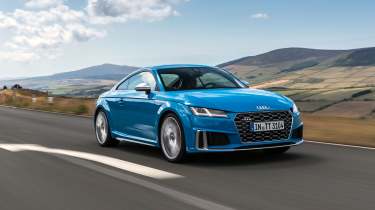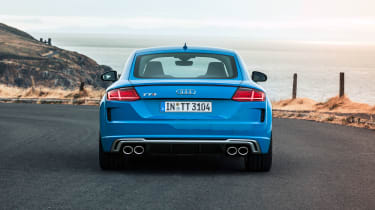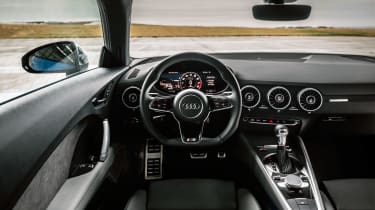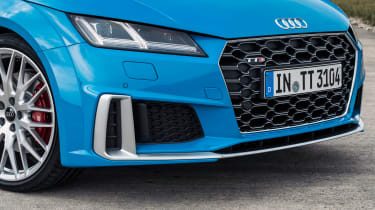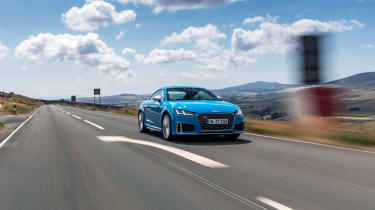Audi TTS 2023 review – can the style icon still cut it?
In its last phase of life, the TTS is a much improved sports coupe, if still not to the same benchmark as rivals from Porsche or Alpine
The Audi TT is entering its twilight years, with the end of production in sight and a run-out Final Edition special recently revealed. A timely moment, then, for a drive in the mid-range Audi TTS, while there’s still time before the last-orders bell tolls. The TTS is the piggy in the middle of the TT range, between the base model and the five-cylinder TT RS range-topper, available in Coupe or Roadster guise.
Compared with the 194bhp/235lb ft 2-litre turbo four in more lowly TT models, the TTS gets a brawnier variant of the same EA888 engine with 316bhp/294lb ft. Direct rivals are few nowadays: mainstream coupes and roadsters have become a rare species. TT alternatives now include more serious sports cars such as the Alpine A110 and Toyota GR86, plus Porsche’s 718 Boxster/Cayman base models. On the convertible front there’s BMW’s Z4 and Mazda’s ever-present MX-5.
The TT’s always convinced as a design statement but its Golf-based platform and forgettable engines haven’t delivered a spellbinding driving experience in its past generations. Still the case for this third-generation TTS?
The TT still shares its basic underpinnings with the Golf via the VW Group’s modular MQB platform arrangement but the Audi employs a significant use of aluminium in the structure, a wider track and stiffer mounting points for the suspension.
More reviews
Its engine is mounted transversely, so the TT makes do with a Haldex-style all-wheel drive system rather than Audi’s traditional quattro system (although there’s still a prominent ‘quattro’ badge on the dashboard), operated via a multi-plate clutch pack on the rear axle. It’s a system used on many current four-wheel-drive cars and the previous TTS, but the system was recalibrated for the current car and allows more power to be sent to the rear axle, especially in the Dynamic driving mode.
The TTS also comes with Audi’s magnetic ride suspension, which through a traditional system of running an electric charge through the magnetised damper fluid, changes the viscosity, and therefore the stiffness, with varying success.
We’ve tested the TTS on optional 20-inch alloys with 30-profile tyres, and although they look impressive they do affect the ride quality. Even the TTS’s magnetic dampers can’t overcome the lack of sidewall.
The softest Comfort suspension mode is more tolerable but the TTS remains restless as the dampers manage larger body movements better than they do wheel control. A rutted or cragged back road can be wince-inducing.
The TT’s interior deserves special mention as it remains, even years after its initial release, one of the most satisfying cabins in the business.
The now-ubiquitous ‘virtual cockpit’ layout (with a digital instrument cluster behind the wheel incorporating the navigation map among myriad other configurable displays) was a real tech-fest on its launch in 2014. Today, the TT’s cabin feels unusual for not having a touchscreen in the middle of the dashboard. None the worse for it, either; there are several ways to do everything, from the buttons on the wheel to the trackpad/clickwheel and shortcut switches on the centre console. In many ways it feels more intuitive and user-friendly than later Audi models’ haptic touchscreens.
The cluster’s graphics are now looking dated, especially the rather blocky map display. The instrument panel’s sheer brightness, regardless of setting, is wearying at night – like sitting too close to your laptop screen – and its full-screen map display party piece doesn’t help all that much, given the letterbox shape it fits shows more of what’s either side of your route rather than what’s up ahead.
Regardless, it still looks great overall and the TT’s reductionist interior design is still perhaps Audi’s most striking and well-integrated execution of its virtual cockpit approach.
The TTS is powered by VW’s venerable EA888 2-litre, turbocharged four-cylinder engine. This engine is used in a multitude of high-performance VW-group applications including the Volkswagen Golf R, Cupra Ateca SUV, Skoda Superb and even the Porsche Macan.
Originally producing 306bhp in the TTS, a particulate filter in later models cut power by 4bhp, but further alterations since now give a 316bhp total.
Torque has increased too, from 280lb ft in earlier cars to 294lb ft. This has helped reduce the TTS’s 0-62mph time by a tenth of a second to 4.5sec.
Thanks to some of these small changes, or perhaps the sports car environment of 2023, the third-gen Audi TTS is one of those cars that seems to have improved with time.
Its silhouette is not classically sporty and that deep-sided shape, relatively high roofline and upright screen are a clue as to the way it drives: in look, layout and feel it’s more like a front-driven hot hatch than a traditional sports coupe.
In previous encounters it’s felt rather anodyne to drive and short on involvement, even if it is long on grip and punch. This 2023 refresher drive reveals a car that’s more responsive and keen in feel than memory suggests: the quick-rated steering, flat cornering stance and immediate performance from the powertrain make for a more engaging car than its reputation might suggest.
Perhaps it’s the curious case of the run-out model; where a car’s gradual development and improvement add up to a noticeably sweeter product than it was at launch.
That said, the Audi TTS still isn’t a driver’s car for the ages. It’s not a car that brims with excitement and feel, nor one that fully immerses its driver in the business of driving.
It still possesses a great deal of appeal though, dynamically as well as visually. It’s such an easy car to extract performance from that, no matter your skill or mood, you can cover ground safely and swiftly on any road in any weather.
Traction is near-absolute in all but streaming wet conditions and grip laterally and under braking impresses too. The TT’s natural bias is very much toward understeer but you can manipulate its attitude on the brakes and off the throttle.
The Haldex system can help too, shuffling power to the rear axle when required.
Acceleration really is rather mighty. The S might not be as explosive as the TT RS but it’s still a rapid car. Its seven-speed dual-clutch transmission aids progress too, with ultra-fast and relatively seamless upshifts.
There are five Drive Select modes: Efficiency, which dampens the throttle map and upshifts earlier to save fuel; Comfort, with light steering and a softer setting for the adaptive dampers; Auto, which plays it by ear depending on your driving style; Dynamic which weights up the steering, firms up the dampers and perks up the throttle and transmission maps; and Individual, where you can mix and match settings for engine/transmission, steering and damping.
Dynamic is best kept for smooth roads, given the already firm damping becomes all the more so, and the steering is made unnecessarily beefy and throttle response too abrupt for many tastes.
Price and rivals
Coupes (and roadsters) like this aren’t really around in the mainstream any more and the TT is now effectively a party of one. It does a lot very well: it’s easy to live with, great in a city (if a touch wearying on a long journey), it still looks stylish inside and out, and in TTS form it’s genuinely fast, too.
The TTS starts just below £50,000 before options. That’s a big jump over the regular TT at around £36,000, albeit more than £10k cheaper than the faster-still TT RS. Its extra speed and kudos over the base TT Sport variant goes some way towards qualifying that steep price, and it is a more rewarding driving experience.
The TTS price puts it right in line with the Alpine A110. The little Alpine is nothing like as quick in a straight line but offers a more delicate, finessed driving experience that’s more satisfying than the Audi, if a little harder to live with as a day-to-day proposition.
A basic Porsche 718 Cayman also remains one of the most complete sports car packages at a tad over £47k, if you can overlook its polarising flat-four engine. It’s also, if anything, even more practical than the TTS with plenty of luggage space and equivalent long-distance comfort.
Whilst it can’t be as gratifying a sports car as a Porsche 718 Cayman, Alpine A110, Toyota GR86 or even a Mazda MX-5, the Audi TTS is more than just a Golf R in a different bodysuit. It has its own character and appeal, and there’s much to like here.

